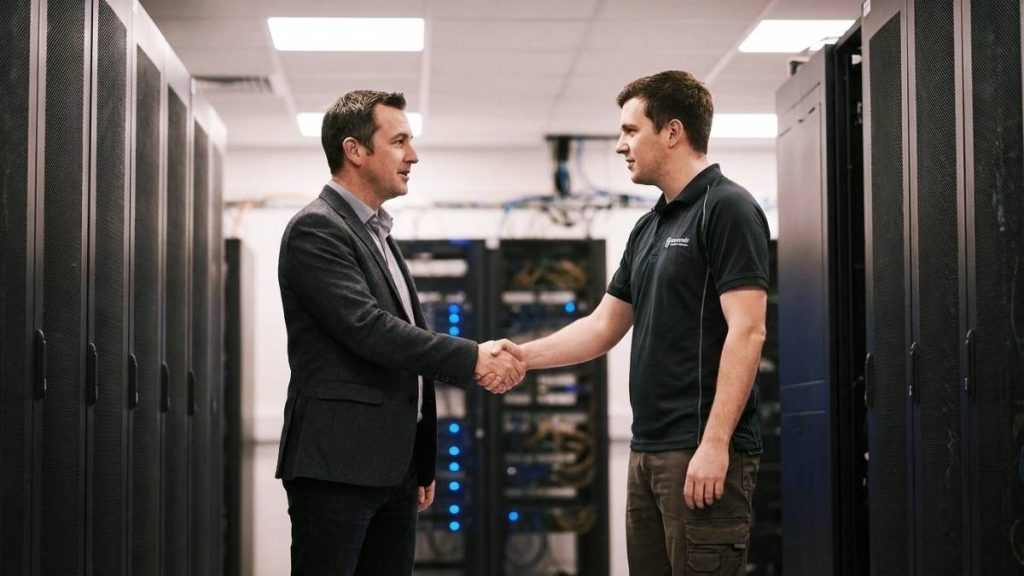Data centers are the backbone of IT operations for countless organizations. They house critical information and applications that keep businesses running smoothly. However, this centralization of sensitive data makes data centers prime targets for hackers and cybercriminals. Understanding the importance of data center security is not just a matter of compliance; it’s essential for safeguarding your organization’s integrity and reputation.

Cyber threats come in various forms, from sophisticated ransomware assaults to insider threats and DDoS (Distributed Denial-of-Service) attacks. These vulnerabilities can lead to catastrophic repercussions, including financial loss and diminished client trust. As technology evolves, so do the tactics used by malicious entities. Therefore, taking proactive measures to fortify your data center’s defenses is crucial. The following sections will explore essential steps to ensure robust protection against these pervasive risks while providing actionable insights tailored for IT managers, cybersecurity professionals, and business executives.
Assessing Current Security Measures
To fortify your data center against potential threats, begin with a comprehensive security audit. This process involves examining all aspects of your infrastructure, including hardware, software, and network configurations. A thorough audit will help you identify weaknesses or gaps in your security measures. For example, an organization recently discovered that its outdated communication protocols allowed unauthorized remote access. The vulnerability was easily overlooked in their initial assessments but significantly jeopardized their security landscape. IT managers can uncover hidden vulnerabilities that cybercriminals could exploit by employing specialized audit tools and methodologies.
Identifying specific vulnerabilities within existing systems is vital for enhancing data center security. This includes analyzing firewalls, intrusion detection systems, and even physical barriers such as badge access and surveillance cameras. Data breaches can occur due to more than just external threats; internal misconfigurations or inadequate employee training can also create significant risks. For instance, if employees are not adequately trained on the importance of using strong, unique passwords, this simple oversight can lead to significant compliance issues or incidents where sensitive information is exposed. Therefore, regular vulnerability assessments via penetration testing and code reviews should become integral practices within your organization’s cybersecurity strategy. Businesses like financial institutions often face stringent regulatory requirements under frameworks such as PCI-DSS; non-compliance in such cases could attract both hefty penalties and loss of customer trust.
By conducting thorough audits, accurately identifying vulnerabilities, and ensuring adherence to industry regulations, you lay a robust foundation for strengthening your data center’s defenses against evolving cyber threats. This proactive stance signals a commitment to security that resonates well with clients and stakeholders alike while bolstering organizational resilience against increasingly sophisticated digital threats.
Implementing Firewalls and Intrusion Detection Systems
In the realm of data center security, firewalls and intrusion detection/prevention systems (IDPS) serve as critical components designed to shield sensitive information from malicious attacks. When selecting firewalls for your data center, it’s essential to understand the various types available. Next-Generation Firewalls (NGFW) are particularly popular due to their ability to perform deep packet inspection and identify threats at multiple OSI model layers. They go beyond traditional port and protocol inspection by incorporating application awareness, which enables them to filter traffic based on specific applications rather than mere IP addresses—a crucial capability given the rise in sophisticated cyber threats.
Moreover, the implementation of IDPS can significantly fortify your defenses against intrusions. These systems actively monitor network traffic for suspicious activity or policy violations and can automatically take steps to block potential threats before they escalate. For example, an IDPS may analyze patterns in network traffic that indicate signs of a Distributed Denial-of-Service (DDoS) attack, allowing IT teams to react proactively rather than in a reactive manner after damage is done. The key benefits of employing such systems include enhanced visibility into network traffic behavior and real-time responses to incident prevention.
Best practices for configuring firewalls cannot be overlooked; proper setup is vital for ensuring maximum effectiveness. Organizations should adopt a default-deny policy while creating firewall rules—meaning all traffic should be prohibited unless explicitly allowed. This approach minimizes potential entry points for threats. Furthermore, regularly revisiting and updating these configurations based on emerging vulnerabilities and refining authentication measures will strengthen their effectiveness over time. Creating segmented network zones within your data center will also add layers of defense; specific firewall rules can then apply according to function or sensitivity, thereby reducing the risk footprint across the entire infrastructure.
To summarize, implementing robust firewalls and IDPS not only establishes foundational security protocols but also effectively prepares data centers for evolving cyber dangers. Regularly assessing these components ensures that organizations remain vigilant against potential breaches while safeguarding valuable data assets with advanced monitoring technologies tailored specifically for today’s dynamic threat landscape.
Securing WAN Connectivity
In today’s interconnected world, securing Wide Area Network (WAN) connectivity is paramount for data center security. As organizations increasingly rely on remote access and cloud services, it becomes essential to encrypt data in transit to prevent unauthorized interception. Encryption transforms readable data into encoded information that can only be deciphered with a specific key or password. For example, implementing Transport Layer Security (TLS) ensures that sensitive information, such as customer data and proprietary business communications, remains confidential during transmission across public networks.
One effective method for safeguarding WAN connectivity is the utilization of Virtual Private Networks (VPNs). VPNs create secure tunnels between remote users or branch offices and the primary data center, allowing encrypted communication even over untrusted networks. This is particularly critical for employees accessing corporate resources from home or on the go. A notable case involved a company that implemented a robust VPN solution during the COVID-19 pandemic; this move fortified their security posture and allowed them to manage an influx of remote workers without compromising sensitive information or operational integrity.
In addition to implementing encryption and VPN solutions, segmenting network traffic offers another layer of protection against potential cyber threats. By dividing network segments based on function or department — such as separating finance from operations — organizations can contain breaches more effectively within isolated segments rather than risking widespread exposure. Techniques such as Virtual LANs (VLANs) facilitate this segmentation by virtually partitioning systems while still operating within a single physical network infrastructure. This approach minimizes attack surfaces and allows for tailored monitoring strategies specific to each segment’s unique risks.
Ultimately, securing WAN connectivity goes beyond choosing the right technology; it necessitates a comprehensive strategy encompassing encryption methods, VPN use, and thoughtful network segmentation techniques. As cyber threats evolve incessantly, ensuring that every layer of your network architecture is fortified against potential exploits not only protects valuable data but also fosters trust among stakeholders who depend on your organization’s integrity and security resilience.
Regular Security Audits and Assessments
Regular security audits and assessments are vital components of a robust data center security strategy. The frequency of these audits should be determined by the sensitivity of the data being handled, regulatory requirements, and any changes to infrastructure or technology. For example, organizations in highly regulated industries like finance or healthcare may necessitate quarterly audits, while others could benefit from semi-annual reviews. Beyond mere compliance, frequent evaluations provide an opportunity to adapt to emerging threats and evolving business needs.
When conducting security audits, it’s critical to focus on key metrics that will offer insight into the efficacy of current defenses. Metrics such as incident response times, the number of vulnerabilities detected, and unauthorized access attempts can highlight both strengths and weaknesses within your system. Additionally, evaluating the effectiveness of existing controls—like firewalls and encryption—is essential for understanding whether they adequately protect against potential breaches. A comprehensive analysis not only reveals vulnerabilities but also offers quantifiable data that can support decision-making regarding future investments in cybersecurity tools.
Utilizing audit findings goes beyond simply identifying areas for improvement; it involves crafting actionable strategies aimed at enhancing your security posture over time. Suppose an audit exposes insufficient staff training on phishing attempts; this insight provides a clear path to developing targeted employee training programs. Similarly, if network segmentation is found lacking during an assessment, immediate steps can be taken to isolate sensitive data more effectively. Organizations can integrate continuous improvement into their security frameworks by treating audit results as actionable intelligence rather than passing reports.
In summary, regular audits serve as both a diagnostic tool and a roadmap for strengthening data center defenses. By committing to a structured approach involving routine assessments—coupled with focusing on relevant metrics—data centers can fortify their existing measures and cultivate an adaptable environment equipped to weather future cyber threats effectively.
Establishing Access Control Mechanisms
Effective access control mechanisms are paramount in safeguarding data center resources and sensitive information. One of the most effective strategies is Role-Based Access Control (RBAC), where permissions are assigned based on a user’s role within the organization. For instance, an IT administrator might have full access to all systems and data, while a customer service representative may only access accounts required for their job functions. By structuring access in this way, organizations can limit exposure to sensitive data and reduce the risk of insider threats or accidental breaches.
Incorporating Multi-Factor Authentication (MFA) is another critical measure that enhances security significantly. MFA requires users to provide two or more verification factors to gain access, such as something they know (a password) and something they have (a smartphone app or hardware token). This form of authentication makes it much harder for unauthorized individuals to gain access, even if they acquire a user’s password through social engineering tactics. For example, consider a financial services firm that employs MFA; by doing so, they substantially mitigate risks associated with remote work environments where phishing attempts can easily occur.
Another essential component of establishing strong access control mechanisms is regularly reviewing user permissions. Over time, roles within an organization can shift due to promotions or departmental changes, leading teams to inherit permissions that no longer align with their responsibilities. Conducting periodic reviews ensures each user maintains appropriate access levels, thus helping identify any excessive permissions that could pose security threats. A practical approach is implementing automated tools that flag unusual permission configurations or unused accounts that could be disabled or further scrutinized.
Together, RBAC strategies, MFA implementation, and regular reviews create a robust framework for protecting a data center from both external attacks and internal vulnerabilities. Organizations must remain vigilant in enforcing these policies and adapt them continuously as technology evolves and new threats emerge. By fostering a culture focused on secure access practices, businesses can minimize risks while enabling productive workflows across various departments.
Fostering a Culture of Security Awareness
Creating a robust security awareness culture within your organization is crucial for the success of any data center security strategy. Staff training on cybersecurity protocols should be comprehensive and ongoing, ensuring that all employees—regardless of their technical expertise—are equipped with the knowledge to recognize potential threats. For instance, phishing attacks remain one of the most prevalent cyber risks; regular workshops can help staff identify telltale signs such as suspicious email addresses, vague language, or unexpected attachments. By integrating real-world examples into training sessions, organizations can make these lessons more relatable and straightforward for employees to remember.
In addition to formal training sessions, simulation exercises are essential in preparing your team for genuine threat scenarios. Role-playing exercises can help staff practice how they would respond to various security incidents, such as ransomware attacks or data breaches. For example, conducting a “red team vs. blue team” exercise—where one group (the red team) simulates an attack while the other (the blue team) defends against it—can uncover vulnerabilities in response strategies and offer valuable insights into improving protocols. Following these simulations with debriefings allows teams to discuss what worked well and areas needing improvement, thereby enhancing overall preparedness.
Encouraging an open line for reporting suspicious activities is another critical component of fostering a culture of security awareness. Employees should feel empowered and supported when reporting anomalies without fearing repercussions or ridicule. Establishing clear communication channels—such as incident reporting tools or designated contacts for cybersecurity issues—can facilitate this process. Additionally, recognizing and rewarding those who report potential threats not only encourages proactive behaviors but also reinforces the importance of vigilance among all staff members.
Ultimately, nurturing a culture of security awareness requires commitment from both leadership and all levels of personnel within the organization. Frequent reminders about the evolving nature of cybersecurity threats should be integrated into daily business practices rather than treated as isolated events. Through continued education and active participation in safeguarding sensitive information, everyone plays a pivotal role in enhancing data center security through collective diligence.
Maintaining Up-to-Date Software and Hardware
In today’s fast-evolving tech landscape, maintaining up-to-date software and hardware is paramount for data center security. Regular updates and patches serve as vital defenses against cyber threats, as they often address vulnerabilities discovered after initial deployment. The 2021 Microsoft Exchange vulnerability highlighted how unpatched systems could be exploited, leading to widespread data breaches. Organizations must implement a structured update protocol that regularly evaluates and applies necessary patches to their systems. By keeping software applications, operating systems, and firmware current, organizations can significantly reduce their exposure to known exploits.
Additionally, managing end-of-life (EOL) equipment is crucial in ensuring robust data center security. Legacy devices often lack contemporary security features or fail to receive timely updates from manufacturers. Therefore, creating a decommissioning strategy for aging hardware can mitigate potential risks associated with using outdated technology. A proactive approach may involve phased replacements or integrating additional security layers—such as firewalls designed specifically for legacy devices—until full migration to more secure alternatives can be achieved.
Adopting a lifecycle management approach can streamline the process of maintaining both software and hardware assets while enhancing overall security posture. This method encompasses planning for regular reviews of all IT resources—from procurement through retirement—and ensures that organizations are equipped with the latest technology suited for evolving cybersecurity threats. Establishing policies for asset acquisition that prioritize compatibility with modern security practices will not only safeguard your data but also optimize operational efficiency in mitigating risks commonly faced by data centers.
By prioritizing regular updates, effectively managing EOL equipment, and embracing lifecycle management as part of IT strategy, businesses considerably bolster their defenses against cyber threats. Recognizing that software and hardware vulnerabilities pose significant risks demonstrates an organization’s commitment to safeguarding its infrastructure and sensitive information in an age when cyberattacks have become increasingly sophisticated.
Incident Response Planning
The inevitability of cyber incidents underscores the necessity for a comprehensive Incident Response Plan (IRP). Developing this plan involves outlining specific protocols and procedures that must be followed when a security breach occurs. An effective IRP should not only identify potential threats but also detail how to respond swiftly and effectively to mitigate damage. For example, including clear guidelines on communication during an incident can prevent misinformation and confusion amongst staff members and stakeholders. By forming a reliable action plan in advance, data centers can significantly reduce response times and restore services with minimal disruption.
Establishing defined roles and responsibilities is crucial during a cyber incident. Each team member should understand their tasks from detection through remediation, ensuring that resources are efficiently allocated amidst chaos. For instance, while IT personnel focus on containing the breach, management may need to handle crisis communications with clients or regulatory bodies. Explicitly assigning these responsibilities in the IRP minimizes confusion and accelerates decision-making processes when every second counts. Furthermore, involving legal counsel in your planning can offer insights into compliance issues arising from breaches, such as GDPR regulations if handling European data.
Testing and refining the response plan through simulation exercises is essential for preparedness. Conducting regular tabletop drills allows teams to practice executing the plan under pressure while identifying any gaps or weaknesses in current strategies. For instance, suppose a data center experiences downtime during a simulated ransomware attack; analyzing this scenario can uncover flaws in communication systems or technology deployments that might slow down actual incident recovery efforts. Continuous evaluation helps organizations adapt their incident response strategies to emerging threats while enhancing their security posture.
Finally, documenting lessons learned from actual incidents or simulations can further strengthen your IRP over time. Integrating these insights creates an evolving framework better prepared to tackle future threats. Regular updates based on new vulnerabilities ensure that your organization remains agile amid shifting cybersecurity landscapes—ultimately reinforcing not just your immediate defense strategies but building resilience as well against subsequent incidents.
Conclusion
Ensuring robust data center security involves a series of essential steps. From conducting thorough security audits to implementing firewalls and intrusion detection systems, each step plays a crucial role in protecting your infrastructure. Securing WAN connectivity and establishing strict access controls are vital to safeguarding sensitive information. Regular staff training and maintaining up-to-date hardware and software further enhance your cybersecurity posture.
Ultimately, a proactive approach is vital to effective data center security. By developing an incident response plan and fostering a culture of awareness, organizations can better prepare for potential threats. Embracing these strategies will not only bolster defenses but also build confidence among clients and stakeholders in the integrity of your operations.







